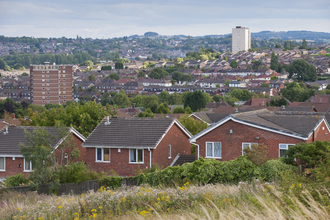At the centre of the UK Government's consultation are changes to England's National Planning Policy Framework (NPPF). This is the rule book that guides the production of local development plans and decisions about development in England.
The Wildlife Trusts believe that all development - be it housing, commercial or infrastructure - should be designed and delivered in a way that contributes to nature's recovery, not its decline. We will be watching this consultation closely and speaking up for nature to be taken seriously as part of the proposed changes, alongside other changes to the planning and development system. In particular, we want to see the changes deliver for:
- wildlife - by improving protections for nature and supporting nature's recovery
- communities - by enabling access to nature and providing communities with a say in development that affects them
- climate - by ensuring habitats that capture and store carbon are protected, while enabling renewable energy opportunties to be explored.
Changes you may have heard about...
Housing
Hitting the news headlines, the housing figures represent one of the most significant changes. A new formula is being proposed that indicates the number of homes local councils should try and plan for to meet the needs of the population (the 'housing need' figure). If adopted it is likely that several local plans (these are plans developed by local councils setting out how and where development should happen) will need to go back to the drawing board.
We welcome the consultation's reference that local councils can set a lower housing target (the number of homes local councils actually plan to deliver) in their local plan "where they can evidence hard constraints", including legally protected nature sites. However, important Local Wildlife Sites - which don't have legal protection - may be placed at threat and should be added to the essential footnotes that lists these hard constraints.
Green Belt
Proposed changes to Green Belts have also featured heavily in the news. As mentioned in our earlier blog, Planning for success, Green Belt land is not designated for the purpose of protecting nature. The proposed changes formalise an approach to releasing land from the green belt in order to deliver new development and introduces the term 'grey belt' to denote areas of Green Belt land that does not contribute to the purposes of the Green Belt's stated aims (which includes preventing urban sprawl and citites, towns and villages from merging into one another). Further clarity will be required to ensure sites with high environmental value within the Green Belt remain protected.
New rules for development on land that has been released from the green belt are also proposed, setting requirements on councils to ensure communities can access nature near where they live. This is an important principle that all development should deliver.
Changes you may NOT have heard of...
Strategic planning
Another area that has seen some proposed changes is strategic planning. Planning at a strategic, larger than local, level facilitates the protection of important nature sites. Planning for nature's recovery should also be embedded in strategic planning. Local Nature Recovery Strategies, which will identify locations to improve nature and provide other environmental benefits are being developed across England. These should become a valuable tool to support strategic planning - and so planning policy should reflect this.
Energy
Away from housing, the consultation also proposes some significant changes to development around renewable energy generation. We support changes that mean onshore wind proposals will be on a level playing field to other development types: our society needs more renewable energy options to produce sustainable, clean energy and to meet net zero commitments. But nature sites must still be protected, including peatlands, which have previously been negatively impacted through renewable energy schemes - but are huge carbon stores in and of themselves, and should not be built on.
What's missing?
Nature
The rapid turnaround of the current consultation is likely to be a key reason why nature is hardly mentioned - and several important changes regarding wildlife are not included in the UK Government's proposals. For example, the points addressed above on Local Nature Recovery Strategies and improved protections for Local Wildlife Sites, or changes to reflect mandatory Biodiversity Net Gain (see previous blog on this here).
Nature's recovery cannot wait. With the UK Government committed to legally binding targets to address nature's decline - the timeframes for which are looming - these improvements to planning policy must be integrated as soon as possible (read more on The Wildlife Trusts' top five priorities for UK Government here).
Community
As the UK Government seek to speed up the development process in England, it is important opportunities for local people to participate in, and influence, planning and development that affects them are not cut.
The views and voices of communities should shape and improve any development proposal. For example, community energy schemes can deliver benefits for nature too; some Neighbourhood Plans have allocated more land for housing development than council-led Local Plans; and local knowledge and values can ensure new development protects wildlife and delivers more for nature.
What next?
Across the network of 36 Wildlife Trusts in England, we will submit a joint response to the consultation. Wildlife Trusts are also meeting MPs and civil servants in the UK Government, to hold them to account on their promises that new development will work alongside nature's recovery.
Further changes to England's planning system are still expected with a new Planning and Infrastructure Bill expected soon. We will also be checking these plans to ensure they deliver for wildlife, communities and climate.
While all these new changes are being considered, Wildlife Trusts continue to respond to hundreds of development proposals where the may impact wildlife.




